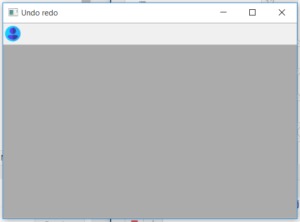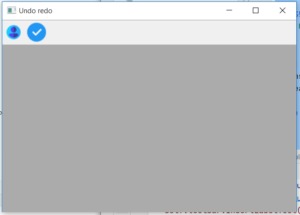在本文中,我們將學習與wxPython中的類wx.ToolBar關聯的InsertLabelTool()函數。 InsertLabelTool()是在工具欄中插入工具的舊方法。 InsertLabelTool()將刀具的不同屬性作為參數插入刀具。
用法:
wx.ToolBar.InsertLabelTool(self, pos, id, label, bitmap, bmpDisabled=wx.NullBitmap, kind=wx.ITEM_NORMAL, shortHelp="", longHelp="", clientData=None)
參數:
| 參數 | 輸入類型 | 描述 |
|---|---|---|
| pos | int | 從0開始在其上要添加工具的位置。 |
| id | int | 一個整數,可以在隨後的操作中標識該工具。 |
| label | string | 該工具將顯示的字符串。 |
| bitmap | wx.bitmap | 主要工具位圖。 |
| bmpDisabled | wx.bitmap | 禁用工具時使用的位圖。 |
| kind | int | 一種工具欄。 |
| shortHelp | string | 此字符串用於工具工具提示。 |
| longHelp | string | 與工具關聯的詳細字符串。 |
| clientData | PyUserData | 客戶端數據的可選指針,以後可以使用GetToolClientData檢索。 |
返回類型:
wx.ToolBarToolBase
代碼示例1:
import wx
class Example(wx.Frame):
def __init__(self, *args, **kwargs):
super(Example, self).__init__(*args, **kwargs)
self.InitUI()
def InitUI(self):
self.locale = wx.Locale(wx.LANGUAGE_ENGLISH)
self.toolbar = self.CreateToolBar()
td = self.toolbar.AddTool(1, '', wx.Bitmap('user.png'))
self.toolbar.Realize()
self.Bind(wx.EVT_TOOL, self.OnOne, td)
self.SetSize((350, 250))
self.SetTitle('Undo redo')
self.Centre()
def OnOne(self, e):
# insert tool at position 1
self.toolbar.InsertLabelTool( pos = 1, id = 3, label ='new tool1', bitmap = wx.Bitmap('right.png'), kind = wx.ITEM_NORMAL, shortHelp ="nono")
self.toolbar.Realize()
def OnQuit(self, e):
self.Close()
def main():
app = wx.App()
ex = Example(None)
ex.Show()
app.MainLoop()
if __name__ == '__main__':
main()輸出:
在點擊個人資料工具之前:

單擊配置文件工具後:

相關用法
- wxPython GetToolPacking()用法及代碼示例
- wxPython wx.ToolBar GetToolState()用法及代碼示例
- wxPython wx.StaticText SetBackgroundColour()用法及代碼示例
- wxPython wx.StaticText SetForegroundColour()用法及代碼示例
- wxPython GetToolByPos()用法及代碼示例
- wxPython wx.StaticText GetLabel()用法及代碼示例
- wxPython GetToolPos()用法及代碼示例
- wxPython GetClassDefaultAttributes()用法及代碼示例
- wxPython wx.ToolBar AddTool()用法及代碼示例
- wxPython FindControl()用法及代碼示例
注:本文由純淨天空篩選整理自RahulSabharwal大神的英文原創作品 wxPython | InsertLabelTool() function in wx.ToolBar。非經特殊聲明,原始代碼版權歸原作者所有,本譯文未經允許或授權,請勿轉載或複製。
